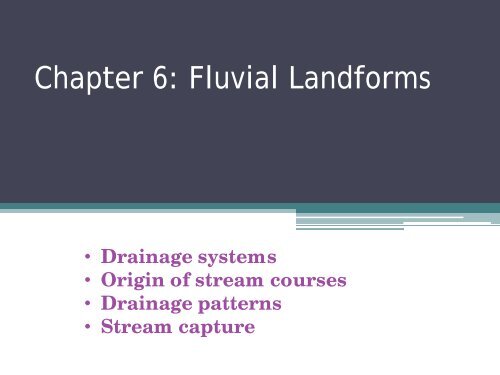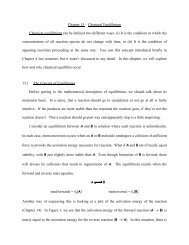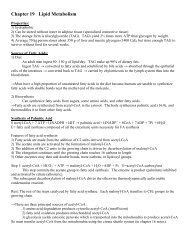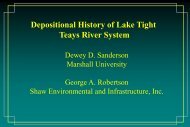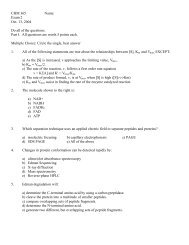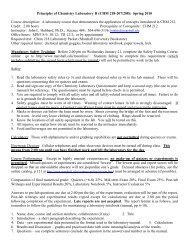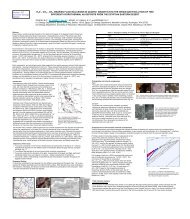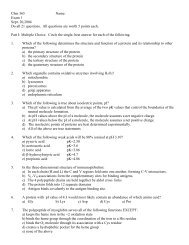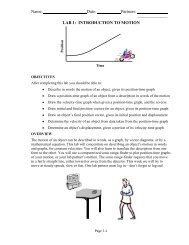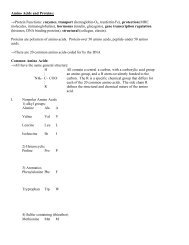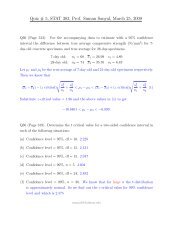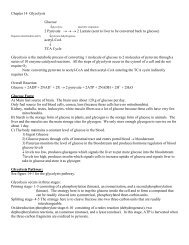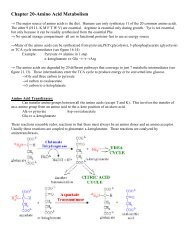Chapter 6: Fluvial Landforms
Chapter 6: Fluvial Landforms
Chapter 6: Fluvial Landforms
You also want an ePaper? Increase the reach of your titles
YUMPU automatically turns print PDFs into web optimized ePapers that Google loves.
<strong>Chapter</strong> 6: <strong>Fluvial</strong> <strong>Landforms</strong><br />
• Drainage systems<br />
• Origin of stream courses<br />
• Drainage patterns<br />
• Stream capture
Hypsometric curves and the stabilization of drainage basin form
• Drainage systems<br />
• stream ordering<br />
• Hortons’s hierarchy of<br />
streams<br />
• lower order streams are:<br />
• shorter,<br />
• steeper,<br />
• drain smaller areas<br />
• Drainage density<br />
• D = L/A<br />
• measure of how well or poorly<br />
a basin is drained by streams<br />
4 th order<br />
drainage<br />
basin
• Drainage systems<br />
• stream ordering<br />
• Drainage density<br />
• D = L/A<br />
• measure of how well or poorly<br />
a basin is drained by streams<br />
•higher for steeply sloping,<br />
low-permeability landscapes,<br />
which promote runoff, gullying,<br />
channeling.<br />
• lower for low-relief, high<br />
permeabilty landscapes.<br />
-what about karst?<br />
drainage texture<br />
-Note crenulated<br />
contours<br />
4 th order<br />
drainage<br />
basin
• Drainage systems<br />
• stream<br />
ordering<br />
• what’s<br />
outlined in<br />
red?<br />
•what’s<br />
outlined in<br />
yellow?
• Origin of stream courses<br />
Virgin land surface (new landscapes)<br />
• fresh volcanics<br />
• newly glaciated<br />
• emergent marine areas<br />
• recently uplifted terranes
• Origin of stream courses<br />
• What determines the path taken by a stream on a<br />
virgin land surface (new landscapes)?<br />
• slope of ground<br />
consequent streams<br />
• random headward erosion<br />
• homogeneous materials<br />
insequent streams<br />
• selective headward erosion<br />
• materials of varying resistance<br />
subsequent streams
• Drainage patterns<br />
Pattern Origin Characteristics Geology<br />
dendritic insequent random,<br />
acute-angle junctions<br />
homogeneous,<br />
horizontal beds<br />
trellis subsequent parallel streams,<br />
high-angle junctions<br />
rectangular<br />
/ angular<br />
subsequent<br />
high-angle junctions,<br />
high-angle bends in<br />
tributaries<br />
heterogeneous,<br />
tilted beds<br />
jointed rocks<br />
annular subsequent circular patterns heterogeneous,<br />
breached domes<br />
radial consequent streams flowing in all<br />
directions from<br />
central high area<br />
volcanic or<br />
intrusive domes
• Drainage patterns<br />
Yemen (very dry climate)<br />
http://www.cerritos.edu/earthscience/tutor/<br />
<strong>Fluvial</strong>/drainage_patterns1a.<br />
htm<br />
New Zealand, Wikepedia<br />
Yangtze River, China<br />
NASA photo
• Drainage patterns
• Drainage patterns
• Stream capture<br />
Diversion of a stream’s flow from its<br />
original channel to the channel of<br />
a neighboring stream.
• Stream capture<br />
Two types:<br />
• abstraction– faster rate of headward erosion on one side of drainage<br />
divide because of steeper gradient or less resistant rocks.<br />
• intercession – lateral movement of meander bend intersects meander<br />
bend of another stream.
• Stream capture<br />
• this is example of<br />
what type of stream<br />
capture?<br />
• where might we see<br />
this in Appalachians?
The Hadhramawt Plateau of South Yemen exhibits a<br />
complex dendritic drainage pattern and excellent<br />
examples of "stream piracy." Wadi Hadhramawt opens<br />
into the sand-filled Ramlat Sabatayn in the southwest<br />
corner of the Rub-al-Khali (The Empty Quarter), yet<br />
drainage is toward the sea. The southern coast of the<br />
Arabian Peninsula is at the upper portion of the<br />
photograph. (S65-34658; Gemini IV.)
• Stream capture
• <strong>Fluvial</strong> landforms<br />
Landform Origin Processes/<br />
Materials<br />
floodplains constructional lateral and vertical accretion,<br />
channel and overbank<br />
deposits<br />
pediments destructional lateral planation,<br />
sheet and rill wash,<br />
weathering,<br />
formation of graded surface<br />
alluvial fans constructional deposition of coarse-grained<br />
sediments on land,<br />
fanhead trenching,<br />
mudflows<br />
deltas constructional deposition in standing water,<br />
turbidity currents,<br />
birdfoot deltas
• The Cycle of Erosion<br />
• introduced by Davis (1909), a foundational concept<br />
in geomorphology for many years, formed basis for<br />
interpreting landforms.<br />
• idealized sequence of landscape/landform evolution.<br />
• begins with uplifted, virgin landscape.<br />
• culminates with featureless plane eroded to base level.<br />
• in between passes through stages, each with a set of<br />
recognizable landforms.
• The Cycle of Erosion
• The Cycle of Erosion<br />
• sequence of forms: 1) youth 2) maturity 3) old age
• The Cycle of Erosion<br />
Youthful stage<br />
• initial drainage poorly developed<br />
• consequent drainage initiated<br />
• low drainage density<br />
• swamps and lakes<br />
• insequent drainage begins to develop<br />
• headward erosion and vertical downcutting dominant<br />
• steep stream gradients promote valley deepening<br />
• narrow, V-shaped valleys
• The Cycle of Erosion<br />
Mature stage<br />
• reduction in basin relief<br />
• streams become graded (adjust to load and discharge)<br />
• stream gradients reduced, valley widening accelerates<br />
• V-shaped valleys transition to flatter profiles<br />
• flood plains develop<br />
• valley sides and divides are smoothed and rounded
• The Cycle of Erosion<br />
Old age – “penelplane”<br />
• gently sloping plane, just above<br />
base level<br />
• very gradual transition between floodplain and valley walls<br />
• real examples hard to find—why?<br />
• uplifted peneplains?—erosional surfaces<br />
• complicated by existence of broad, flat surfaces not result<br />
of fluvial processes.
• The Cycle of Erosion<br />
Stage Landscape Processes<br />
youthful<br />
steep hillsides,<br />
drainage divides predominant<br />
V-shaped valleys<br />
headward erosion,<br />
stream downcutting<br />
mature<br />
rounded hills,<br />
valley walls predominant<br />
graded streams<br />
broad floodplains<br />
lateral erosion,<br />
streams adjust to<br />
discharge/load<br />
old age<br />
“peneplane,”<br />
close to base level<br />
very low relief,<br />
sluggish stream flow,<br />
poor drainage
• Cyclic stream terraces<br />
• former valley floors that lie above active stream<br />
channels.<br />
• result from:<br />
• uplift<br />
• change in base level<br />
• change in load/discharge<br />
• interrupts cycle of erosion
• Types of cyclic stream terraces<br />
• cut-in-bedrock terraces<br />
• bedrock terraces<br />
• covered by thin veneer of alluvium<br />
• interpreted events:<br />
• erosion by graded stream<br />
• uplift/change of base level<br />
• downcutting<br />
• fill terraces<br />
• composed of alluvium, depositional in nature<br />
• interpreted events:<br />
• filling of valley by aggradation of graded stream<br />
• uplift/change of base level<br />
• downcutting
• Types of cyclic stream terraces (cont.)<br />
• cut-in-fill terraces<br />
• composed of alluvium, erosional in nature<br />
• interpreted events:<br />
• valley cut into alluvium<br />
• uplift/change in base level<br />
• downcutting<br />
nested fill terraces<br />
• composed of alluvium,<br />
• multiple terraces, all depositional in nature<br />
• successive cycles of aggradation and downcutting
• Non-cyclic surfaces<br />
• erosional surfaces on resistant materials<br />
• do not represent periods of sustained erosion but rather<br />
a resistant surface.<br />
• slope of surface conforms to bedding, not to slope<br />
of stream that formed it.<br />
• may slope up-valley<br />
• will not have concave-upward profile as a valley<br />
floor would.


